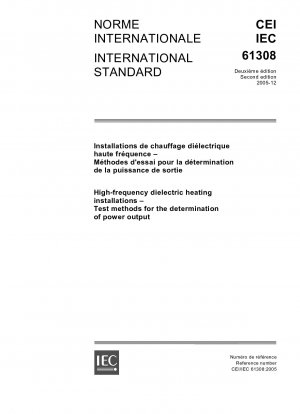IEC 61308:2005
High-frequency dielectric heating installations - Test methods for the determination of power output
- Standard No.
- IEC 61308:2005
- Release Date
- 2005
- Published By
- International Electrotechnical Commission (IEC)
- Latest
- IEC 61308:2005
- Replace
- IEC 27/495/FDIS:2005 IEC 61308:1994
- Scope
- This International Standard is applicable to industrial high-frequency dielectric heating installations used for the purpose of thermal applications such as melting, drying, welding, insect extermination, and gluing of partially conductive or non-conductive materials such as plastics, wood, rubber, textiles, glass, ceramic, paper, bamboo or foodstuffs, in both normal and protective atmospheres, using, for example, inert gases or vacuum. This standard relates to high-frequency dielectric heating installations with nominal dielectric heating frequency in the range from 1 MHz to 300 MHz with rated useful output power greater than 50 W. The main purpose of this standard is to assist in compliance with the requirements set out in 6.4 of IEC 60519-9 when testing electroheating power sources. It is not primarily intended as a means of representing a potential high-frequency heating application for the requirement of the user. Due to the large variety of dielectric heating applications, any output power value obtained as a result of these tests should not always be taken as representing the power that can be dissipated in a particular dielectric heating installation, but, in certain instances, the output power value could be used as an indication of performance. The power required to heat a charge is dependent, for example, on the type of material heated, the temperature of heating and ambient moisture and on the construction of the electrode system. NOTE Heating a charge with dielectric parameters deeply changing in time and/or temperature the value of the output power obtained with the actual charge may be different from that obtained in standard test conditions. For equipment working outside the ITU-designated bands, the frequency of the generator follows the resonant frequency of the output circuit, thus the output power can remain fairly stable during the work cycle, even with hand tuning of the output circuit. Therefore, according to this standard, the test well represents the actual output power in practical work conditions. For equipment working in ITU-designated bands, the frequency of the generator remains stable, but the resonant frequency of the output circuit varies with the change of dielectric parameters of the load. Therefore, the value of the mean output power in the work cycle can be much lower than the value obtained in the test conditions. This value depends on the time response of the eventual automatic tuning system. This standard relates to equipment normally operating under continuous rated conditions.
IEC 61308:2005 Referenced Document
- IEC 60050-841:2004 International Electrotechnical Vocabulary - Part 841: Industrial electroheat
- IEC 60519-9 Safety in electroheat installations - Part 9: Particular requirements for high-frequency dielectric heating installations
IEC 61308:2005 history
- 2005 IEC 61308:2005 High-frequency dielectric heating installations - Test methods for the determination of power output
- 1994 IEC 61308:1994 High-frequency dielectric heating installations - Test methods for the determination of power output
